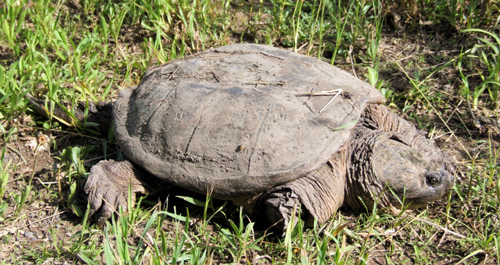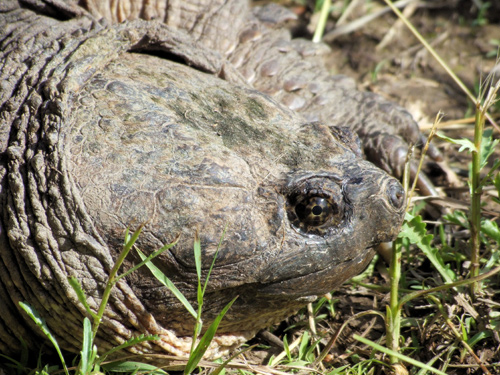The common snapping turtle is a large turtle. If you think snapping turtles look prehistoric, that is because they are prehistoric. The snapping turtle has been around for 200 million years and was present before the dinosaurs. Its shell, or carapace, is brown or black and often covered with mud or algae. The rear edge is saw-toothed. The lower shell, or plastron, is small. The turtle's body is leathery. The head is large and horny with a sharp beaked mouth and powerful jaws. The tail is long, plated and spikey. The carapace of snapping turtles can be 8 to 18 1/2 inches long. The largest recorded Connecticut specimen weighed nearly 20 pounds. Common snapping turtles can reach 50 pounds.
Common snapping turtles range through the eastern 2/3 of the US. They are widespread in Connecticut.
Note that the alligator snapping turtle is a different species of snapper found in southern states farther west than New England. Those often huge freshwater turtles can weigh 175 pounds, but do not live around here.
Common snappers are hardy and adaptable. They live in all types of water from polluted urban ponds to wilderness lakes. They can also tolerate some tidal, brackish habitats. They like to rest in warm shallows, often buried in mud.
Snapping turtles can breed from April through November. Females can store sperm for several years. Eggs are usually laid in May or June. A female digs a flask-shaped nesting cavity, about 4 to 7 inches deep, in sandy soil in a warm, sunny spot. She lays 20 to 50 sperical eggs resembling ping-pong balls. Each egg is covered with soil by the mother's hind feet as it is laid. Females often travel some distance from the water to find a good nesting site. They are vulnerable to being run over if they cross roads to find a good spot. Incubation takes 9 to 18 weeks and depends on the weather. Usually eggs hatch in August or September, but some hatchlings overwinter in the nest and come out in spring. When they emerge they head for water. The turtles reach sexual maturity at about 6 years. A snapping turtle's lifespan is estimated to be 30 or 40 years.
The gender of baby snapping turtles is determined by the temperature of the eggs during a particular stage of development. This is common for many turtle species. In an incubation study, temperatures of 58 degrees F produced all females. Temperatures of 73 degrees F produced all males. At 77 degrees F, all females were produced again. The temperature within a natural nest can vary, so a clutch can produce mixed gender babies.
These turtles hibernate for the winter. They use dens in overhanging banks, under debris or sometimes use a muskrat house. They emerge from hibernation in April. They are mostly nocturnal and have secretive habits.
Snapping turtles are omnivorous. Their diet includes invertebrates, carrion, fish, birds, small mammals and aquatic plants.
Snapping turtles will try to avoid humans by swimming away. If threatened or handled they can strike viciously. They can give a serious bite with their sharp powerful beak. Don't underestimate their reach, they have a long neck. It is best to leave them in peace.

